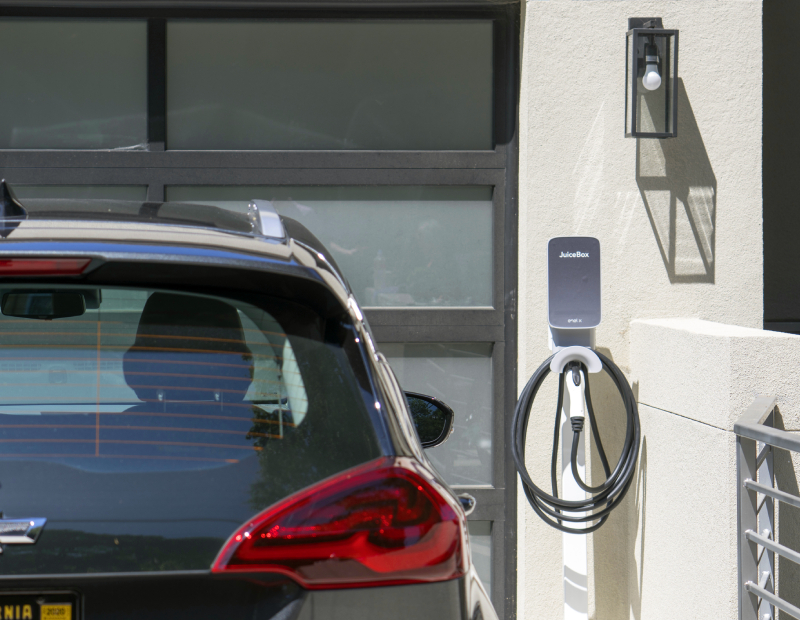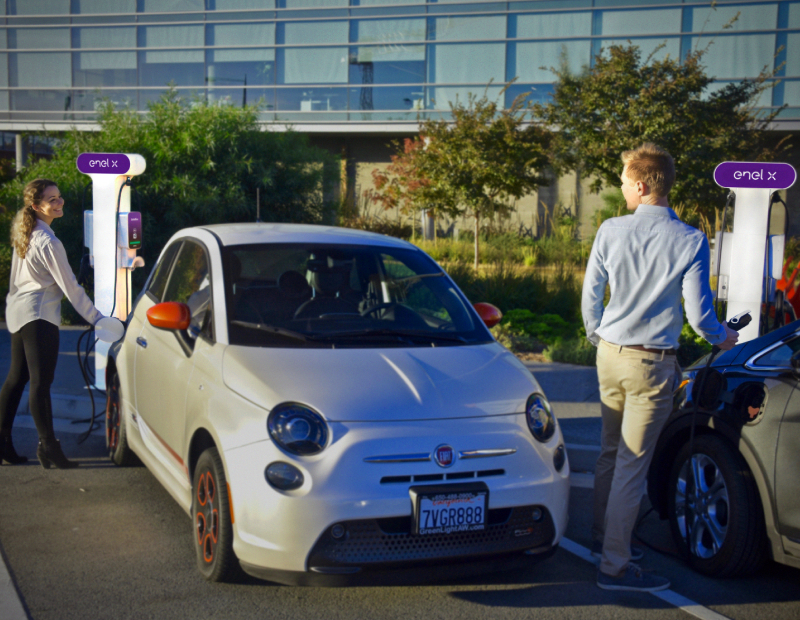Get Ahead of the Coming EV Wave
Electric vehicles are the future, experts say, and now is the time to take advantage of financial incentives to install chargers at commercial properties.

JuiceBox EV residential charger. Image courtesy of Enel X North America
When it comes to electric vehicles, commercial real estate owners and operators face one fundamental question: Do they wait for a tidal wave of EVs on the road to add charging stations to new and existing buildings, or get ahead of that tsunami? The answer increasingly is if they dawdle, they run the risk of finding themselves behind the times.
A recent study released by The Brattle Group, a Boston-based economic consulting firm, predicts that the number of EVs on American roads will increase from 1.5 million in 2020 to between 10 million and 35 million by 2030. The surge in adoption is fueled by a growing number of state policies mandating EVs; a marked decline in EV and battery costs; and anticipated growth in new EV models available from manufacturers.
READ ALSO: EV Stations Spark Broad-Based Change
“Property owners should be aware significant efforts are being undertaken by utilities and utility regulatory commissions to ensure infrastructure is in place,” said Mike Hagerty, senior associate with The Brattle Group.
In many states, utilities are able to cover costs of building out most of the “make-ready” infrastructure—up to but not including the chargers themselves—to provide charging of commercial properties. “They are able to charge back the cost to all rate payers, rather than that one location, reducing the cost of adding chargers for specific properties while supporting state-level EV and decarbonization goals,” Hagerty added.
EV charging infrastructure is being discussed as part of a stimulus package in the U.S. House of Representatives, Hagerty said. Twelve states comprising 30 percent of the U.S. population have already instituted Zero Emission Vehicle mandates. Three more states have recently proposed to adopt the program.
Ten states have put building codes in place that essentially require buildings to be EV-ready, said Elise Benoit, vice president of marketing, e-Mobility for Enel X North America, one of the world’s largest electric utilities and renewable energy producers and manufacturer of the JuiceBox EV charger.
READ ALSO: High-Tech, High-Powered Changes
Earlier this year, the International Code Council published new codes encouraging the addition of EV stations to new-construction buildings. Other recommendations strongly advise retrofitting existing buildings. In California, CALGreen legislation mandates 250,000 EV charging stations be publicly available by 2025 and calls for six percent of parking spaces be EV-capable in new non-residential buildings, Benoit said.
In New York City, there has been talk of a reexamination and strengthening of Local Law 130, which requires commercial buildings to be 20 percent EV-ready with adequate electrical capacity, conduits and breakers to accommodate future additions of chargers, said Amina Hassen, urban planner with WYZ Studio, a New York City urban design practice .
Different by industry
About 80 percent of EV charging takes place at the home, 15 percent in the workplace and the remainder happens on the go, Enel X North America estimates.

JuiceBox EV charger pedestals. Image courtesy of Enel X North America
Those charging on the road depend on public charging stations, which are highly differentiated by industry, according to Alison Alvarez, CEO of BlastPoint, a Pittsburgh-based predictive analytics company. Because most charging takes hours rather than minutes, commercial properties such as hotels, high-end retailers, restaurants and theaters are installing chargers as inducements to high-value patrons to stay awhile and fork out cash. “Where we see it most is in hotels because most charging happens overnight,” Alvarez said. “Hotels, B&Bs, resorts, spas, we see a lot of growth in the luxury travel category.”
Predictably, adoption is anything but uniform. California commercial real estate owners are far more likely to adopt EV charging than those in West Virginia, for example. “It makes sense to think about your own situation, and your own target customer,” Alvarez noted. “It’s what their values are and what you want to reflect back to them. There’s a reason almost every Whole Foods has a charging station.”
Key considerations
Decision-makers should consider several factors when exploring EV charging. Choose a networked charging solution with smart features and automated software updates, advises Daryll Harrison, senior director, global communications and social media with Campbell, Calif.-based EV-charging infrastructure company ChargePoint. That step will future-proof the investment, while providing insights into users’ charging behaviors.
Harrison offered additional tips:
- Prepare for more EV owners by ensuring additional parking spaces are EV-ready, with conduit and electrical wiring connected to a power source.
- Develop a charging policy highly scalable to accommodate future EV drivers.
- Select a vendor with hardware certified for safety, designed for indoor and outdoor use and featuring 24-7 driver support.
- Choose a pricing model that makes sense for your business.
- Take advantage of all available grants, rebates and tax credits.
Many of the incentives are being offered by utilities, Enel X’s Benoit said. Rebates and make-ready incentives cover installation, equipment costs and ensuring that equipment can be connected to the grid. Property owners should strongly consider leveraging incentives while funding is available to support development of charging infrastructure. “In 15 years, when everyone is driving an EV, some of those incentives may not be available,” she said. “Start looking at it right now. There’s no reason to wait . . . In some cases, the cost of the capital investment could be covered up to 100 percent by incentives available in your area.”
Taking the lead
Owners and operators should strongly consider taking the initiative on EV charging now, rather than being forced to scramble when tenants demand the amenity, said Tim Curran, CEO of Building Engines, a building operations platform for CRE. He urges owners to equip parking garages, lots and spaces with EV charging at a minimal charge to tenants.
“There may not be too many EVs to accommodate today,” he said. “But the revolution is coming . . . Taking a proactive approach toward EV charging, building owners and operators can allow for a better tenant experience, maximize rent rolls and gain a cleaner environment—a win for everyone.“







You must be logged in to post a comment.